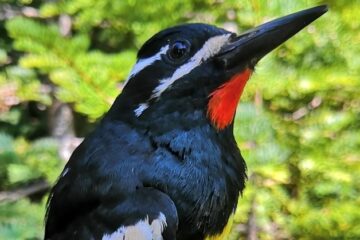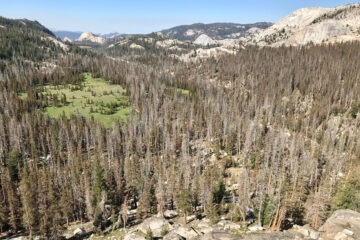Whenever UC Merced student Yazmin needed a reminder of why she was spending her summer break working deep in one of Yosemite’s sequoia groves, she would recall her coworker’s advice: “Just look up and realize what you are doing.”
Looking up at a giant sequoia requires some serious neck-craning. Sequoiadendron giganteum can be hundreds of feet tall, their upper branches forming a sky-scraping canopy high above. And you can’t look up without also looking back in time, sometimes more than 1,000 years, to when those rare giants were just tiny seedlings peeking out of the soil.
Those towering mature trees — and their offspring — were at the heart of Yazmin’s Yosemite summer. As a Student Conservation Association intern working on a sequoia-focused project supported by Conservancy donors, she gained firsthand experience in field research while exploring what it takes to ensure that new generations of giants thrive.
You’ll find Yosemite’s most famous set of sequoias at the southern end of the park, in Mariposa Grove, where a multiyear restoration effort wrapped up in 2018.
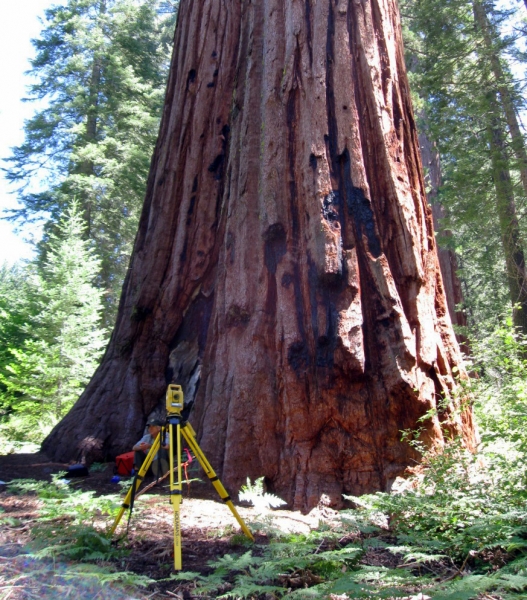 For this post, we’re focusing on Yosemite’s two smaller sequoia groves: Tuolumne and Merced, near Crane Flat. In 2013, through a donor-funded research grant, crews surveyed the two groves for rare plants and wildlife, analyzed each grove’s fire history and population structure, and mapped and measured 550 sequoias, finding trees ranging from waist-height to nearly 300 feet. Their work led to a couple of key findings:
For this post, we’re focusing on Yosemite’s two smaller sequoia groves: Tuolumne and Merced, near Crane Flat. In 2013, through a donor-funded research grant, crews surveyed the two groves for rare plants and wildlife, analyzed each grove’s fire history and population structure, and mapped and measured 550 sequoias, finding trees ranging from waist-height to nearly 300 feet. Their work led to a couple of key findings:
Key Finding No. 1: Trees (or, more accurately, tree roots) were getting trampled. Sequoia roots are very shallow, often no more than 6 feet underground. The human footprint left by thousands of visitors passing through the groves each year, with many people leaving established trails in order to get closer to the massive trunks, was resulting in a network of informal “social trails” and threatening the health of the trees.
Key Finding No. 2: Both groves had a notable lack of young trees and seedlings, likely due to a lack of fire, which helps release sequoia seeds from cones and clears the forest floor to make room for new giants.
Not long after the 2013 surveys had been completed, the Rim Fire swept through the park and created a serendipitous study situation: While the Merced Grove remained unburned, crews ignited a controlled “back-burn” blaze in the Tuolumne Grove to protect the ancient trees from the approaching wildfire. That preventive action opened a window to study how fire affects sequoia seedlings, by comparing the burned and unburned sites, gathering key information to inform future fire management.
The next step? Take action!
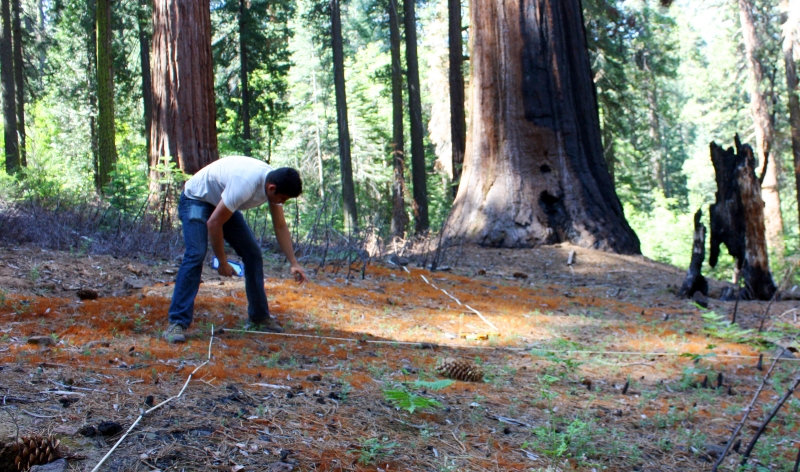 In 2015 and 2016, with support from our donors, Yosemite scientists focused on studying the conditions that young sequoias need to thrive. In 2015, careful counts revealed 768 seedlings — all in Tuolumne Grove, and almost all (97%) in survey plots that had experienced a light- to medium-intensity burn.
In 2015 and 2016, with support from our donors, Yosemite scientists focused on studying the conditions that young sequoias need to thrive. In 2015, careful counts revealed 768 seedlings — all in Tuolumne Grove, and almost all (97%) in survey plots that had experienced a light- to medium-intensity burn.
Results showed that the depth of the duff, the layer of leaves, twigs and other organic material that lines the forest floor and can be reduced by fire, seemed to influence seedling counts. Shallow duff meant more seedlings; no seedlings were found in the unburned Merced Grove plots.
Sequoias haven’t been the only research subjects in the groves. Scientists also studied people, observing how different tools, such as low fences, natural brush barriers and signs, help deter visitors from getting too close to the trees. Along the way, crews of park staff, volunteers and interns removed 39 social trails in the two groves, replacing hiker-generated paths with healthy habitat.
Such protective measures have become even more pressing. When Mariposa Grove closed for a temporary period to facilitate restoration (starting in mid-2015), visitation to its northern neighbors tripled.
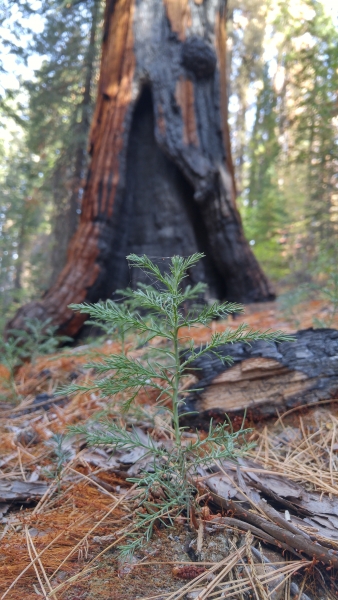 A 2016 crew (which included Yazmin, two other interns, and a Yosemite Leadership Program graduate working as a seasonal NPS vegetation and restoration employee) continued efforts to restore and protect the groves while digging even deeper into sequoia science. Their research focused on documenting microenviromental conditions in burned areas, such as humidity, light, and soil moisture, to determine why juvenile trees do better in certain locations. The team also collected soil samples and sequoia clippings to analyze nutrients present in the ground and trees.
A 2016 crew (which included Yazmin, two other interns, and a Yosemite Leadership Program graduate working as a seasonal NPS vegetation and restoration employee) continued efforts to restore and protect the groves while digging even deeper into sequoia science. Their research focused on documenting microenviromental conditions in burned areas, such as humidity, light, and soil moisture, to determine why juvenile trees do better in certain locations. The team also collected soil samples and sequoia clippings to analyze nutrients present in the ground and trees.
Most of the time, the sequoia crew is looking down, searching for seedlings, taking soil measurements, eliminating social trails or building fences. But as Yazmin says, when you take a break to look up at the ancient, towering trees overhead, “they ground you.” Stretching hundreds of feet above the survey plots, the mature sequoias are a striking reminder of the value of this work.
Three field seasons combining research, habitat restoration, new protective measures and hundreds of hours of volunteer time are a blip in the lifespan of a giant sequoia, but could be vital for the long-term survival of the groves. By taking advantage of a scientific window, and taking thoughtful steps to protect Yosemite’s giant sequoias, this work helps ensure that today’s mature trees and the next generation of giants can thrive and continue to inspire new stewards and supporters of the natural world.
Top photo: Student Conservation Association intern Yazmin hard at work in one of the sequoia survey plots. (Yosemite Conservancy)

